Directions (1-5): Study the following pie chart and line chart carefully to answer the following questions. Pie chart shows the percentage distribution of pairs of shoes manufactured by 5 shoe manufacturers and line chart shows the number of pair of formal shoes manufactured by these manufacturers.
Note: Total pair of shoes manufactured = Total pair of formal shoes manufactured + Total pair of casual shoes manufactured.
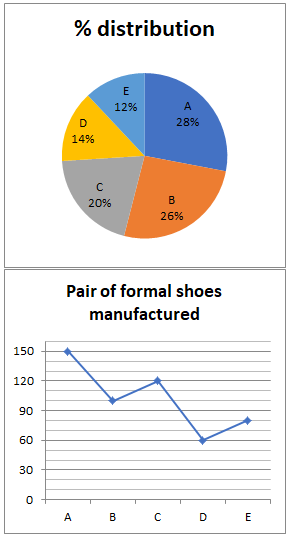
Q1. Manufacturer-B sold all pair of shoes manufactured by him and he had earned 20% profit on selling all the pairs. Total revenue of manufacturer–B is Rs. 11856 and average cost of manufacturing one pair of formal shoes is Rs.26. If pair of shoes manufactured by manufacture-A is 280, then find average cost price of a pair of casual shoes for manufacturer B.
(a) Rs. 38.5
(b) Rs. 45.5
(c) Rs. 50.5
(d) Rs.62.5
(e) Rs.89.5

Q2. Number of pairs of casual shoes manufactured by manufacturer-A & B together is 310 more than the number of pairs of formal shoes manufactured by manufacturer-A & B together. Then, find difference in total pairs of shoes manufactured by manufacturer-E and manufacturer-C
(a) 150
(b) 100
(c) 190
(d) 120
(e) 230

Q3. Average of number of pairs of shoes manufactured by all manufacturers is 280. Then, find pairs of casual shoes manufactured by manufacturer-A & E together is approximately what percent more or less than number of pairs of formal shoes manufactured by manufacturer-C & D together?
(a) 95%
(b) 81%
(c) 74%
(d) 89%
(e) 83%.
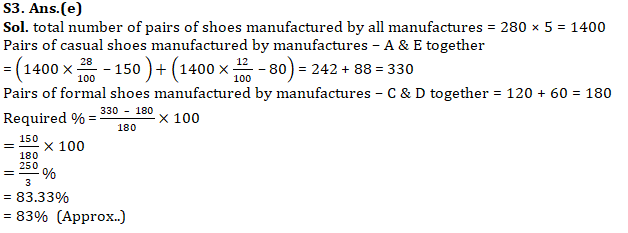
Q4. Ratio of number of pairs of formal shoes to pairs of casual shoes manufactured by manufacturer-C is 4 : 5. Then, find ratio of total number of pairs of formal shoes manufactured by manufacturer-B, C and E together to pairs of casual shoes manufactured by manufacturer-A & D together.
(a) 91 : 99
(b) 112 : 113
(c) 100 : 119
(d) 121 : 126
(e) None of the above.

Q5. Find the central angle (in degrees) disclosed by manufacturer-A & C together.
(a) 160
(b) 152.4
(c) 166.8
(d) None of the above
(e) 171.2
![]()
Directions (6-10): The following questions are accompanied by two statements A and B. You have to determine which statements(s) is/are sufficient/necessary to answer the questions.
Q6. A person finds that his son’s age after ‘x’ years will be 3/8th of his age at that time, his wife finds that ratio of age of his only son after x years to her age at that time will be 3:7. Find the average of their (all three) present age?
I. That person is 5 years older than that of his wife.
II. Ratio of present age of father to that of his son is 6:1.
(a) Statement I alone is sufficient to answer the question, but statement II alone is not sufficient to answer the questions
(b) Statement II alone is sufficient to answer the question, but statement I alone is not sufficient to answer the question.
(c) Both the statements taken together are necessary to answer the questions, but neither of the statements alone is sufficient to answer the question.
(d) Either statement I or statement II by itself is sufficient to answer the question.
(e) Statements I and II taken together are not sufficient to answer the question.

Q7. Ratio of distance covered by a boat in upstream to that of in downstream is 2:3 and time taken by boat to cover that upstream distance is equal to the time taken by the boat to cover those downward distance. Find the speed of boat in still water?
I. Difference of speed of boat in still water to that of speed of boat in upstream is 5 km/hr
II. Boat will cover 50 km of distance in upstream in 2.5 hours.
(a) Statement I alone is sufficient to answer the question, but statement II alone is not sufficient to answer the questions.
(b) Statements I and II taken together are not sufficient to answer the question.
(c) Either statement I or statement II by itself is sufficient to answer the question.
(d) Both the statements taken together are necessary to answer the questions, but neither of the statements alone is sufficient to answer the question.
(e) Statement II alone is sufficient to answer the question, but statement I alone is not sufficient to answer the question.
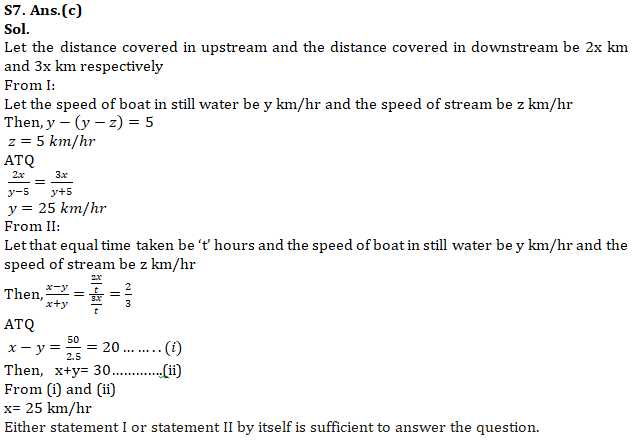
Q8. We have to choose from 6 women and 9 men for the post of HR and Operation Management in-charge in which minimum 2 woman has to be selected. What is the probability that both the persons selected are un-married?
I. only 2 women are married.
II. The number of men who were unmarried was twice of number of unmarried women.
(a) Both the statements taken together are necessary to answer the questions, but neither of the statements alone is sufficient to answer the question.
(b) Statement II alone is sufficient to answer the question, but statement I alone is not sufficient to answer the question.
(c) Either statement I or statement II by itself is sufficient to answer the question.
(d) Statement I alone is sufficient to answer the question, but statement II alone is not sufficient to answer the questions.
(e) Statements I and II taken together are not sufficient to answer the question.

Q9. Three persons A, B and C together can do a work in 8 days while A, B and D together can do that work in![]() days. Find in how many days B alone will do that work?
days. Find in how many days B alone will do that work?
I. A alone takes 4 days less than that of C alone to do that work and time taken by A alone and D alone to do that work is equal.
II. Ratio of efficiency of A to that of B is 3:2 and ratio of efficiency of C to that of D is 5:6.
(a) Both the statements taken together are necessary to answer the questions, but neither of the statements alone is sufficient to answer the question.
(b) Statement II alone is sufficient to answer the question, but statement I alone is not sufficient to answer the question.
(c) Statements I and II taken together are not sufficient to answer the question.
(d) Statement I alone is sufficient to answer the question, but statement II alone is not sufficient to answer the questions.
(e) Either statement I or statement II by itself is sufficient to answer the question.
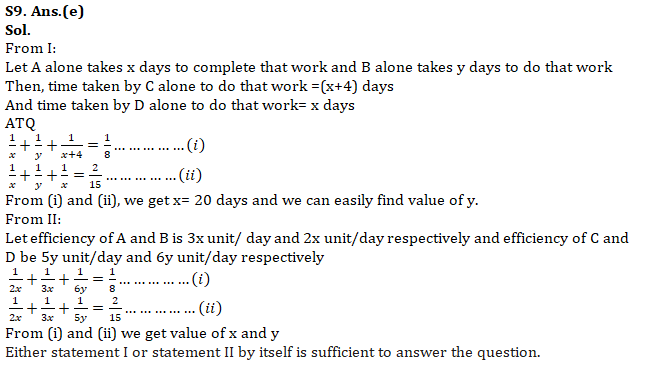
Q10. At the end of a year of starting a business, P and Q earns total profit of Rs. 60,000, calculate the profit-share of Q.
Q invested Rs. 40000 more than P.
II. Both of them invested for 12 months, but P also take 20% of total profit as a salary share.
(a) Statement I alone is sufficient to answer the question, but statement II alone is not sufficient to answer the questions.
(b) Statement II alone is sufficient to answer the question, but statement I alone is not sufficient to answer the question.
(c) Statements I and II taken together are not sufficient to answer the question.
(d) Both the statements taken together are necessary to answer the questions, but neither of the statements alone is sufficient to answer the question.
(e) Either statement I or statement II by itself is sufficient to answer the question.

Directions (11-15): Find the wrong number in the following series:
Q11. 15, 91, 457, 1831, 5497, 10997
(a) 457
(b) 91
(c) 5497
(d) 15
(e) 10997

Q12. 10, 17, 45, 108, 220, 390
(a) 220
(b) 390
(c) 10
(d) 108
(e) 45
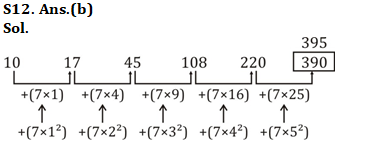
Q13. 10, 30, 90, 450, 3150, 34650
(a) 10
(b) 34650
(c) 3150
(d) 3150
(e) 30

Q14. 325, 546, 754, 936, 1078, 1170
(a) 936
(b) 546
(c) 325
(d) 1078
(e) 1170
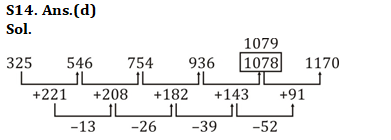
Q15. 100, 127, 252, 877, 4002, 19627
(a) 4002
(b) 252
(c) 100
(d) 127
(e) 19625

For 200+ most important arithmetic questions
- Quantitative Aptitude Study Notes for Bank Exams
- 100 MCQs Data Interpretation | Download Free PDF’s of DI
- Quantitative Aptitude Questions for all Competitive Exams
All the Best BA’ians for IBPS RRB PO/Clerk Main

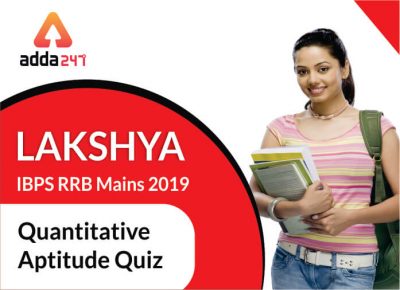



 GA Capsule for SBI Clerk Mains 2025, Dow...
GA Capsule for SBI Clerk Mains 2025, Dow...
 The Hindu Review October 2022: Download ...
The Hindu Review October 2022: Download ...
 SBI Clerk Prelims Result 2025 Out, Direc...
SBI Clerk Prelims Result 2025 Out, Direc...







